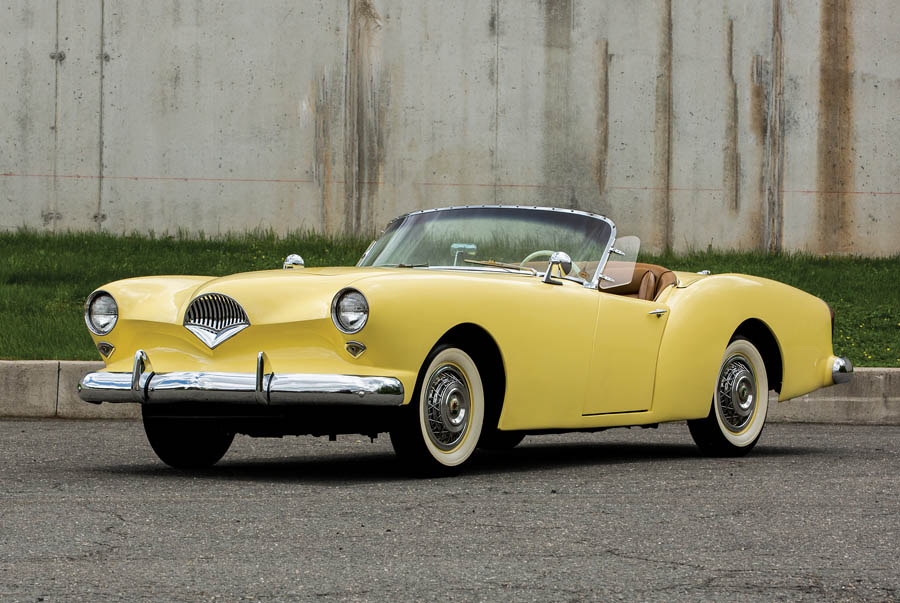SCM Analysis
Detailing
| Vehicle: | 1954 Kaiser-Darrin 161 Roadster |
| Years Produced: | 1954 |
| Number Produced: | 435 |
| Original List Price: | $3,668 |
| SCM Valuation: | $138,900 |
| Tune Up Cost: | $200 |
| Chassis Number Location: | Left front door post |
| Engine Number Location: | Right front corner of engine block |
| Club Info: | Kaiser Frazer Owners Club |
| Website: | http://www.kfclub.com |
| Alternatives: | 1954 Chevrolet Corvette, 1955 Ford Thunderbird, 1955 Chrysler C-300 coupe |
| Investment Grade: | B |
This car, Lot 148, sold for $90,200, including buyer’s premium, at Bonhams Greenwich Concours d’Elegance Auction in Greenwich, CT, on June 4, 2017.
In the early 1950s few — if any — women were in responsible decision-making positions in the male-dominated automotive industry. If it were not for a lady, however, the Kaiser-Darrin would have never seen the light of day.
Howard “Dutch” Darrin had a respected career in both Europe and California, creating exciting automotive designs for screen stars, entrepreneurs and the landed gentry. After the war, however, the market for custom coachwork had diminished, and Darrin entered a tumultuous and contentious relationship with Kaiser-Frazer as a freelance consultant.
He quickly resigned, however, when his design for the 1946 sedan was altered without his approval by the “orange juicers,” as he called the company designers. No one was sorry to see him go, but two years later, they sought his help on styling for the ’51 Kaiser. He relented and returned, but his tenure was again short-lived. When the company chose a lesser design — in his opinion — for the Henry J, he walked out the door once more.
Darrin could not let his Henry J design go. At his shop in Santa Monica he built a clay mockup of his sleek sports car on the Henry J chassis. He did this without the knowledge or approval of Kaiser management and he financed the project out of his own pocket.
He enlisted Glasspar to body his mold using glass-reinforced plastic, now commonly known as fiberglass. When it was complete, he invited the Kaisers to view the prototype. Henry J. Kaiser reportedly was not pleased and expressed no interest in the project. But his new wife’s enthusiasm for the car carried the day. Kaiser acquiesced, and as a result of his wife’s opinion, the Kaiser-Darrin was born.
The fiberglass body was certainly novel, beating the Corvette to the market by several months, as were the sliding doors that Darrin had patented in 1946. The three-position top had functional landau irons, and the high shell-shaped grille is thought by some to resemble a guppy gasping for air. The car was powered by the 161-ci Willys “Hurricane” 6-cylinder engine that produced 90 horsepower, but even with a 3-speed manual transmission, its performance was anemic.
Unique and expensive
Priced at $3,668, the Darrin was expensive, and sales were never brisk. By 1955, Kaiser-Willys had left the U.S. market, and with only 435 Kaiser-Darrins produced, the car is but a one-year footnote in automotive history — but the car continues to be significant with today’s collectors.
The last 50 Kaiser-Darrins produced were damaged in a storm and were stored in a facility near the Willys plant. As production had ceased, they were ordered to be destroyed. Darrin was able to acquire them and sold them at his Hollywood showroom until the end of 1957. He retrofitted many with superchargers and multiple carburetors to improve performance. The final six were fitted with Cadillac V8 engines, one of which was raced by the legendary Lance Reventlow in SCCA events.
Even with limited production, Kaiser-Darrins appear at auction with regularity, so values can be easily tracked. They have suffered a malaise similar to the one that has affected the ’50s American-car market, but this sale was a recent low. As noted in the auction description, the car was restored a couple of decades back and now shows imperfections and patina — auction-speak for wear. It would appear that a respray and perhaps other work is in order. If the new owner can do some of the heavy lifting on his own, he just may be financially above water and the car was well bought. If not, call this a car with needs at a market-correct price.
(Introductory description courtesy of Bonhams.)
